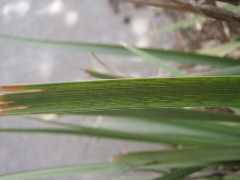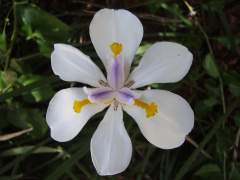Fortnight Lily, African Iris
Dietes vegetaFamily: Iridaceae
Podcast Script
Fortnight Lily: Plant |
Fortnight Lily: Flowering Stalk |
 Fortnight Lily: Leaf |
 Fortnight Lily: Flower |
Classification:
Angiosperm, Monocot, evergreenSize:
Fortnight Lilys can grow 4 to 5 feet tall when grown in standing water. When grown in soil they can grow 2 to 3 feet tall. The width of the plant is 1 to 2 feet wide.Identifying Features:
Sharp and long leaves radiate from the center of the plant. Also it's bright white flowers that peak out above the leaves. They are grass like plants that are usually clumped into groups.Location/Habitat:
The Fortnight Lily originated from eastern to southern Africa including Kenya.These plants that are non-native to Northern America has been introduced and dispersed into the environment of the southern part the Hardiness Region. To be specific these plants thrive in the USDA zone 8-11. These regions are generally hot and the temperatures do not reach bellow 10 degrees Fahrenheit.
Flower/Fruit/Reproduction:
The flower of the Iris has six petals and is mostly white. Bright colors like white, yellow, and light purple help attract bees and other insects. The flower stalks are perennial so they should not be cut.The Fruits are elongate to half and inch to 1 inch long. The fruits are dry and hard. They are green in color and they persist on the plant.
The seeds can produce a mature Fortnight Lily but also a Fortnight Lily can be divided in half after flowering. These two ways can produce a mature Fortnight Lily.
Water/Sun Requirements:
The Africa Iris can withstand little sunlight and poor soil conditions. For optimal conditions the plant should be in an area with a lot of sun shine and regular watering. They are moderately resistant to drought and flooding.Special Adaptations:
The Fortnight Lily has many adaptations, for example it has thin grass like leaves that retain water. Also its roots are shallowly located in the ground. This adaptation helps absorb a lot of water in a short period of time during rainy days. Fortnight Lily, once established, can withstand dry conditions. These plants are easy to grow from seed to plant. They require very little maintenance which makes the Fortnight Lily an ideal plant to grow indoors and out.Other Info:
The Fortnight Lily is an ideal plant to add to the landscape. Even though the flowers last for a few days and they burst out at different times through spring until late summer. The flowers can be admired through a large period of time.Reference Sources/Links:
.http://hort.ufl.edu/shrubs/DIEVEGA.PDFhttp://aggie-horticulture.tamu.edu/extension/newsletters/hortupdate/june05/Dietes.html
http://www.floridata.com/ref/D/diet_iri.cfm
http://rareseedsource.com/proddetail.php?prod=dietes
http://www.mobot.org/gardeninghelp/plantfinder/Plant.asp?Code=B969
Created By: Daniel B. 2007